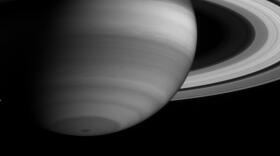-
Strange Universe With Bob BermanThese nights the first few hours after nightfall let us see the brightest part of our Galaxy. The next night it’s clear, you’ll find the Moon is absent. So if you’re away from city lights and you let your eye dark adapt for a few minutes, you’ll see the creamy glow of the Milky Way right overhead, splitting the sky in half from North to south. Tune in to hear what you need to catch that perfect glimpse of the stellar night sky.
-
Strange Universe With Bob BermanThere’s an eclipse happening! It happens September 17 at 10:12 p.m. Eastern Daylight Time. Since the Moon orbits around us at a speed of 2,287 miles an hour, it normally takes a full hour for its 2,160-mile-wide body to plunge completely into Earth’s dark umbral shadow. Tune in to hear more about what’s happening in the sky!
-
Strange Universe With Bob BermanSaturn arrives at its closest point to Earth of the entire year. So let’s locate it. It’s the ONLY bright star in that entire section of the heavens. We’ll also discuss Saturn’s composition and its journey around the sun.
-
Strange Universe With Bob BermanThis week we’ll see a Perseid meteor shower. But if clouds spoil the spectacle for you, there will be lingering meteors. This shower’s intensity falls off rapidly after peak, so later you might only see a meteor every 3 minutes after midnight. Tune in to hear about the reddish stars and what to check for the in the sky!
-
Strange Universe With Bob BermanA century ago the famed astronomer Percival Lowell believed an unknown “planet X” was gravitationally tugging on Uranus and Neptune. So the wealthy Lowell founded an Arizona observatory to try to detect this ninth planet. We’re reminded of all this because this past week is when Pluto has come to its closest to Earth of 2024.
-
Strange Universe With Bob BermanAll the interactions in the universe can be explained by gravity, electromagnetism, and the two forces, strong and weak, that operate only within atoms. This week: The String Theory.
-
Strange Universe With Bob BermanOn Tuesday night the crescent Moon hovers next to the famous blue star Regulus. As the brightest luminary in Leo the Lion, the ancient Persians considered it one of the “four royal stars,” famous for sitting in the center of the zodiac, which is why it sometimes meets the Moon.
-
Strange Universe With Bob BermanThe dark matter problem started with the famous Swiss physicist Fritz Zwicky in 1933, when he studied galaxy motion in the giant Coma group. What he perceived was astonishing. Each member moved so quickly, it should have no problem escaping the gravitational glue of the entire assembly. Zwicky realized that this galaxy cluster — and all others, it soon turned out — shouldn't even exist. Yet there they were.
-
Strange Universe With Bob BermanJupiter passed behind the Sun a week ago, so it’s still lost in the solar glare. By next month, early risers will start seeing brilliant Jupiter in the east before dawn, as a morning star. But when we think of that giant planet, people who care about astronomy think of its strange moon Europa, which is probably the likeliest place for life in the known universe.
-
Strange Universe With Bob BermanIn the category of cool naked-eye sky events, you’ve got eclipses, comets, meteor showers, and the event happening right now – a bright conjunction. Tune in to hear about one of the best conjunctions of the year!

Play Live Radio
Next Up:
0:00
0:00
Available On Air Stations










